Steve Nash retires: The numbers behind his Hall of Fame career

Steve Nash, a two-time MVP and eight-time All-Star point guard who guided some of the most dynamic offenses in NBA history, formally announced his retirement on Saturday, bringing his sterling 19-year career to an end. The future Hall of Famer will be remembered as one of the most unselfish and creative floor generals of all time, a 6'3" wizard who tormented defenses with his excellent shooting touch, superb vision and a futuristic understanding of angles and positioning.
Here's a look at 10 numbers that defined Nash's career, which included stops with the Suns, Mavericks and Lakers.
15
"The NBA is the major dream in my life and the grail I chase every day," a college-aged Nash told Tim Crothers for a 1995 Sports Illustrated profile. "I am obsessed with it."
The overflowing legacy of Steve Nash
Phoenix made that once-unlikely dream come true, selecting Nash out of Santa Clara University with the 15th pick in a 1996 draft that also included the likes of Allen Iverson, Marcus Camby, Stephon Marbury, Ray Allen, Kobe Bryant, Peja Stojakovic, Jermaine O'Neal and Derek Fisher. "Loaded" doesn't begin to describe that class, and Nash retires ranking third among his classmates in minutes, fourth in points, first in assists and third in Win Shares (behind Bryant and Allen).
Nash, who was born in South Africa, took an unconventional route to finding himself a first-round pick sharing the stage with such elite company. A high school star in British Columbia, Canada, Nash was famously overlooked by college recruiters before enjoying a standout four-season career at Santa Clara. Crothers noted that Nash's "deranged" devotion to the game was a constant presence in his life: "Last week Nash could be found dribbling his mangy tennis ball between his legs for an hour without a double dribble as he sat on a threadbare couch at the off-campus house he shares with four teammates." The profile also noted that upon meeting the college-aged Nash, Magic Johnson signed a photo of the two point guards: "Good luck from Big Magic to Little Magic."
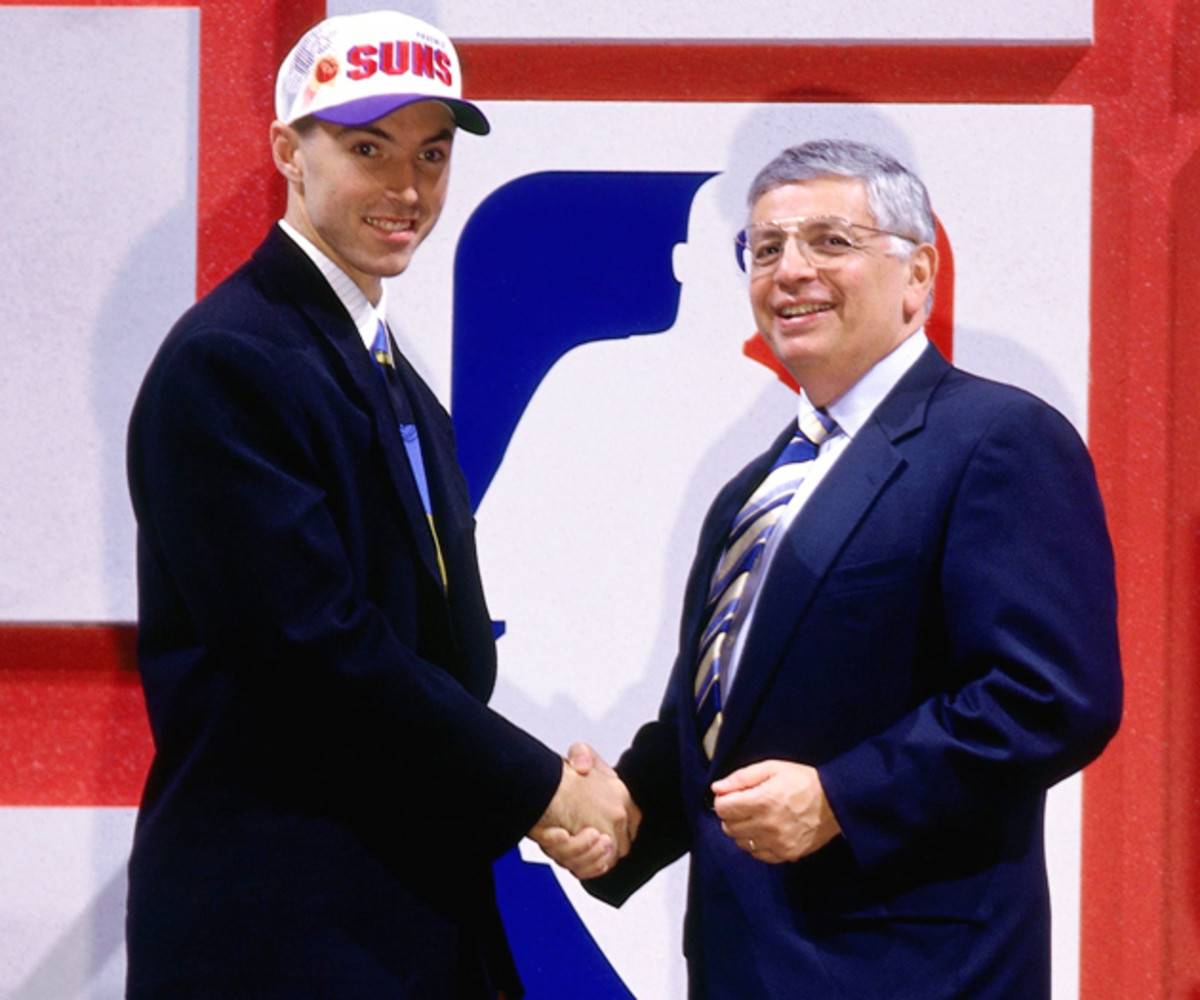
9
Nash's NBA acclimation wasn't immediate. He spent two seasons with the Suns as a backup to Kevin Johnson and Jason Kidd before being traded to the Mavericks in 1998. His stats during his first two seasons in Dallas were nothing to write home about, either, as he averaged 8.6 points and 4.9 assists at age 25.
Things began to take off in 2000-01, when, as Richard Hoffer wrote for Sports Illustrated, he learned to better balance his responsibilities as a scorer and a distributor under coach Don Nelson.
"His first objective," says fellow Mav Michael Finley, "is keeping everyone else in the game."He's so selfless it's almost irritating. No, it actually is irritating, at least to his coach. In Nash's first season with Dallas, 1998-99, he spread the ball every which way, and coach Don Nelson engaged him in a long tug-of-war over Nash's reluctance to shoot.
"He wants to pass first," says Nelson. "I guess it's O.K. to be that way on a certain kind of team, but I needed him to get 15 points every night. I had to tell him once that he had to shoot at least 10 times a game. It was hard for him. It went against his grain, I guess."
...
That was typical of Nash: always trying to dole it out when he could simply stop and pop. Doing things any other way goes against his grain. Now, though, with the demands of the modern game requiring more than self-sacrifice, he's learning to mix in the shooter's ego, becoming a player whom both teammates and coach can love. He should be fun to watch this season, straddling basketball eras as easily as he does countries, looking to share but, all the same, increasingly willing to take the open shot.
Nash started 70 games and averaged 15.6 points and 7.3 assists that year, guiding Dallas to the league's fourth-best offensive rating.
Once the floodgates opened, they stayed open. The following year, 2001-02, Nash ran a Mavericks offense that ranked No. 1 in offensive efficiency. That season began a staggering nine-year streak in which Nash's teams possessed the NBA's most-efficient attack. It didn't matter whether Nash moved from Dallas back to Phoenix in 2004, if he swapped Dirk Nowitzki for Amar'e Stoudemire, or whether he played for Nelson, "Seven Seconds or Less" originator Mike D'Antoni, or Alvin Gentry. Nash's teams finished at the top of the charts, playing a key role in ushering in the three-heavy game we see today.
• MORE NBA: Open Floor | Week's top plays | NBA draft roundtable
This reign over the NBA's offensive charts reinforces the notion that Nash wasn't merely an individual weapon but rather served as the head of the snake for a ruthless team attack. "He does as much coaching as the coaches," teammate Steven Hunter told Sports Illustrated's Chris Ballard in 2005.
2
Perhaps the most debated aspect of Nash's career are his two MVP awards, claimed during his second Phoenix stint in 2005 and 2006. In 2005, Nash guided Phoenix to the league's top offense, 62 wins and a trip to the Western Conference finals, where they lost to Tim Duncan's Spurs (the eventual champions). In 2006, he led the Suns to the league's best offense, 54 wins and the Western Conference finals, where they lost to Nowitzki's Mavericks.
[daily_cut.NBA] In 2005, Nash beat out Shaquille O'Neal, Nowitzki, Duncan and Iverson to claim MVP honors. The following year, he topped LeBron James, Nowitzki, Bryant and Chauncey Billups. At the center of these debates were questions about Nash's defensive abilities, about whether some of the other candidates were more dominant individual players or better all-around players, whether Phoenix's style was revolutionary or gimmicky and whether Nash was simply a product of Phoenix's system.
Jack McCallum wrote for Sports Illustrated in 2006 that Nash was aware of the doubters.
Nash also admits that last season's MVP award is sometimes on his mind. He remembers all the thrills that came with it—the congratulatory phone call from 1957 MVP Bob Cousy and the one from 2004 MVP Kevin Garnett, who "welcomed me to the club," Nash says—and he thinks, What if I fall on my face? "But I'd be thinking that anyway," he says, with a smile. "People have always told me I'd fall on my face, that I wouldn't make it this far. But here I am."
Regardless of the debates, Nash is one of just 12 players to win multiple MVP awards, along with Bob Pettit, Bill Russell, Wilt Chamberlain, Kareem Abdul-Jabbar, Moses Malone, Larry Bird, Johnson, Michael Jordan, Karl Malone, Duncan and James. At 6'3", Nash is the shortest player in NBA history to win multiple MVP awards and the only point guard other than Johnson who has done so.
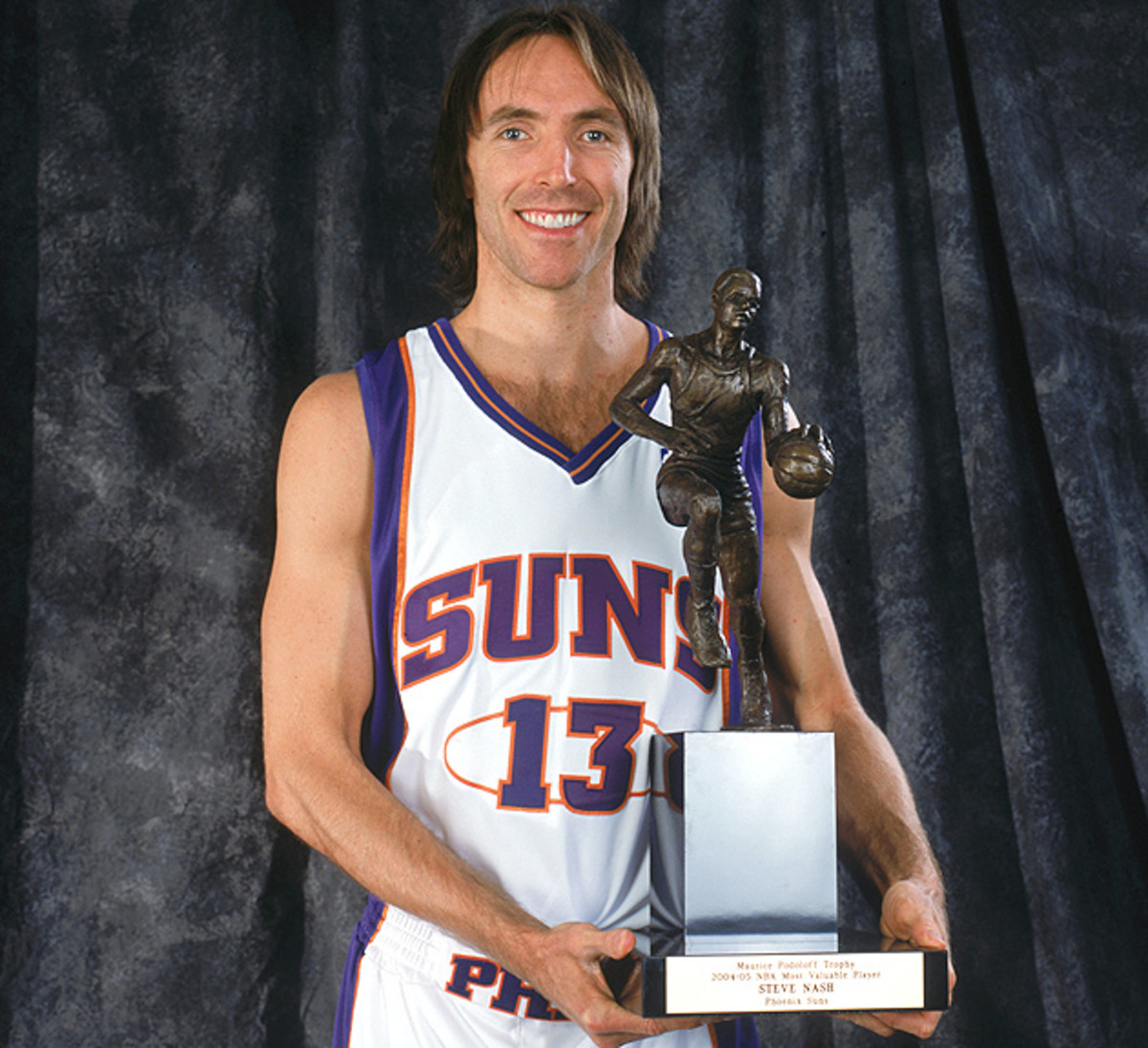
118.2
All those fun-and-gun seasons with Nowitzki and Nelson, and then D'Antoni and Stoudemire, really added up. "If we run this [pick-and-roll with Nash], I don't care what the defense is doing, they're not stopping it," D'Antonitold Sports Illustrated's Lee Jenkins in 2012. "We may mess up or miss a shot, but you can't really stop it."
A decade-plus of unstoppable offense will put you near the top of the charts. Indeed, despite the slow start to his career and a forgettable final few seasons in Los Angeles, Nash's 118.2 offensive rating ranks 10th all-time. Among point guards, he trails only Chris Paul (122.5), Johnson (120.8), and John Stockton (120.6) in career offensive rating. By comparison, Nash beats out Jordan (118), James (115.9), Kevin Durant (115.5), and Bryant (111).
10,335
The signature individual statistic of Nash's career was his 10,335 assists, good for third all-time behind Stockton (15,806) and Kidd (12,091). That tally reflects Nash's longevity, his vision, his creativity and his soccer-style upbringing which emphasized setting up teammates and making the best possible use of space.
Nash's next-level passing skill was highlighted by Ballard in 2007.
Nash's other unusual skill is his ability to pass with one hand. In the game against the Mavericks, by one unofficial count, 47 of his 68 passes are one-handed (or primarily so). One in particular has a ridiculous degree of difficulty: a crosscourt lefthanded scoop pass from outside the three-point line, which assistant coach Alvin Gentry calls the "southpaw slinger." Later on Nash dribbles along the right wing and, without breaking stride, throws a one-handed backdoor bounce pass to Leandro Barbosa for a layup. What's remarkable about the play is that Nash doesn't change anything—the height of the dribble, his speed, the position of his body—to ready the pass. He merely moves his hand from over the ball to behind it. "If I could make every pass with two hands I would," Nash says. "But if I gather with two hands every time, that cuts down exponentially the amount of avenues and openings on the court."
50/40/90
The "50/40/90" club has long been a catchy way to identity the league's premier shooters, guys who are capable of sinking 50 percent of their field goals, 40 percent of their three-pointers and 90 percent of their free throws.
This is an exclusive club whose only qualified members are Bird, Jose Calderon, Durant, Steve Kerr, Reggie Miller, Nash, Nowitzki and Mark Price.
As McCallum noted in 2006, Nash was a great shooter because he worked and worked and worked at it.
But any story about Nash, the Phoenix Suns' point guard who has his team fighting for the best record in the Western Conference (despite playing all season without 6'10" superstar-in-ascension Amaré Stoudemire), must begin in that most conventional of basketball settings (a gymnasium) with his working on that most conventional of skills (shooting). It is 45 minutes before the Suns are to play the Golden State Warriors at US Airways Center in Phoenix, and Nash is the only player in the team's practice gym. He shoots, equipment manager Jay Gaspar retrieves.
Nash begins near the basket, then gradually moves farther away, firing jumper after righthanded jumper with what Dallas Mavericks assistant coach Del Harris calls "absolutely perfect mechanics," his right palm facing the ceiling as he releases, his wrist snapping on each follow-through. Next Nash launches a dozen runners, some off his left foot and some, unconventionally, off his right. He moves through his practice ritual according to some internal rhythm ("I change spots when it feels right," he says), eventually stepping behind the three-point arc (from where he makes 17 of 24) and finally settling in at the free throw line (making 11 in a row).
Nash hit the 50/40/90 threshold a record four times: in 2006, 2008, 2009 and 2010. The only other player to reach the 50/40/90 club multiple times? Bird in 1987 and 1988.
• MORE NBA: The Fundamentals | Kareem in SI Vault | Big Board
90.4
Although it's not necessarily the sexiest record, Nash retires with the NBA's best career free-throw percentage: 90.4. To get there, Nash shot better than 90 percent in seven out of nine seasons from 2003-11, topping out with a personal best of 93.8 percent in 2010.
It's worth noting that Nash was never a particularly high-volume free-throw shooter. He averaged four free-throw attempts per game just once in his career, 2003, and he isn't among the top 200 players of all-time in career free throw attempts.
181
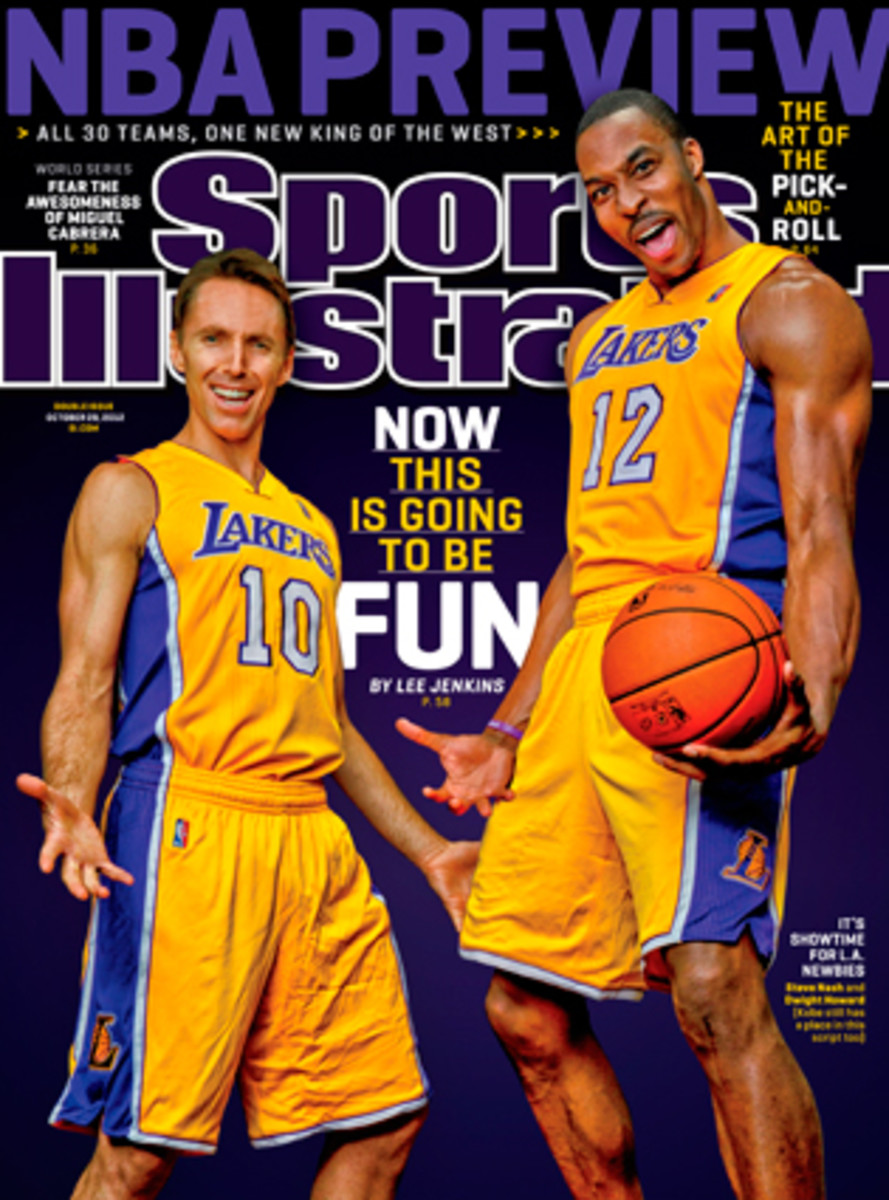
For all his record-setting peaks with the Suns, Nash's career began to slide in 2011-12, when the post-Stoudemire Suns failed to make the playoffs for the second straight season. That offseason, Nash landed with the Lakers in a sign-and-trade deal that teamed up Nash with Bryant and Dwight Howard. The splashy moves make the Lakers an early title favorite, but they didn't wind up producing much in the way of success.
"When I signed with the Lakers, I had big dreams of lifting the fans up and lighting this city on fire," Nash wrote on The Players' Tribune. "I turned down more lucrative offers to come to L.A. because I wanted to be in the “fire,” and play for high risk and high reward in my last NBA chapter. In my second game here, I broke my leg and nothing was the same."
During his three-year stint with the Lakers, Nash will miss 181 out of a possible 246 games due to injury. The one-time title favorites received just 61 postseason minutes from Nash, they lost Howard in free agency and they have endured three straight season-ending injuries for Bryant, all while firing coaches Mike Brown and D'Antoni. Instead of going out with a bang, Nash's career faded into the sunset as he tried and failed to overcome back and nerve problems for much of his three-year contract with Los Angeles.
41
Nash walks away from the game at age 41, joining a fairly short list of players to take the court after their 40th birthdays. Notable members of the 40-plus club include: Kevin Willis, Robert Parish, Dikembe Mutombo, Abdul-Jabbar and Malone. Other guards in the group include Cousy, Stockton, Jordan and Kidd.
0
Like Stockton, Malone, Charles Barkley and Patrick Ewing before him, Nash retires with the cruelest of asterisks: he never won an NBA championship. In fact, he never advanced to the Finals, although he did play in four Western Conference finals (one with Dallas, three with Phoenix). Noting that his former Mavericks teammates advanced to the Finals in both 2006 and 2011, winning the 2011 title, really twists the knife. Nevertheless, Nash professes no bitterness.
"Dirk and the great city of Dallas got their championship, and I couldn’t be happier for them," Nash writes. "It will always hurt that Phoenix Suns fans didn’t get the championship they deserved during our run. Yes, we had some bad luck but I always look back at it and think, I could’ve made one more shot, or not forced a turnover, or made a better pass. But I don’t regret anything. The arena was always sold out and rocking. It was the time of my life. Thanks, Phoenix."
GALLERY: Rare photos of Steve Nash
Rare Photos of Steve Nash
Steve Nash
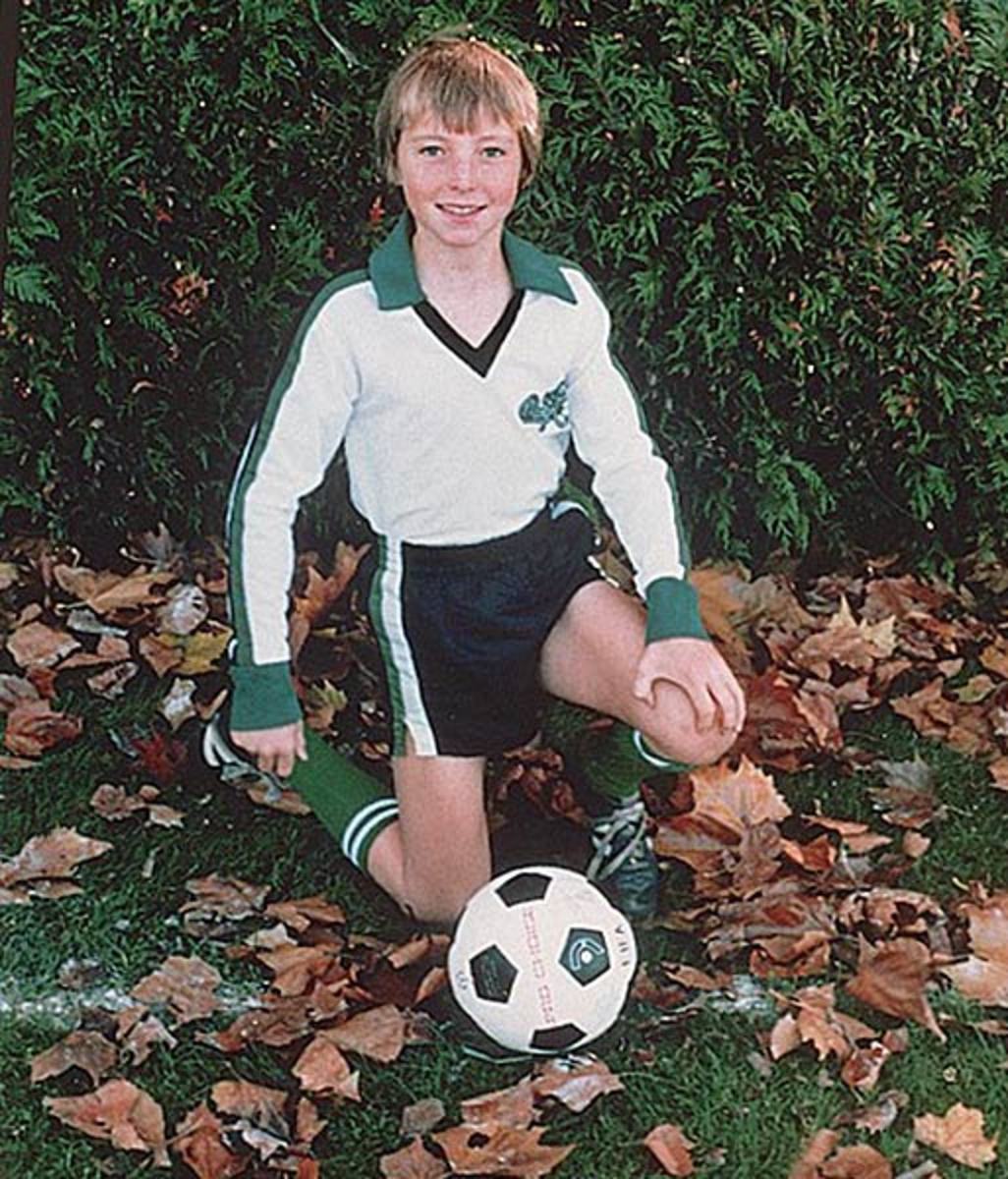
The two-time NBA MVP was born in Johannesburg, South Africa. His father played professional soccer and the family lived in a number of places before setting in Victoria City near Vancouver.
Steve Nash

Like most Canadian boys, Nash quickly fell in love with hockey. His favorite team was the Vancouver Canucks and his favorite player was Wayne Gretzky. He also played lacrosse and rugby, but didn't discover basketball until the eighth grade.
Steve Nash

Though he was one of the top basketball players in Canada, Nash was not highly regarded as a recruit. The only scholarship offer he received was to Santa Clara, on the condition that Nash improve his suspect defense.
Steve Nash

Nash was an immediate hit on the court, leading Santa Clara to its first NCAA Tournament appearance in five years. The No. 15 Broncos upset Arizona in the first round before losing to Temple the following game. Despite the loss, Nash had Santa Clara on the national radar. He would lead the team to two more tournament appearances over the next three years as he garnered a reputation as one of the nation's top point guards.
Steve Nash and Allen Iverson
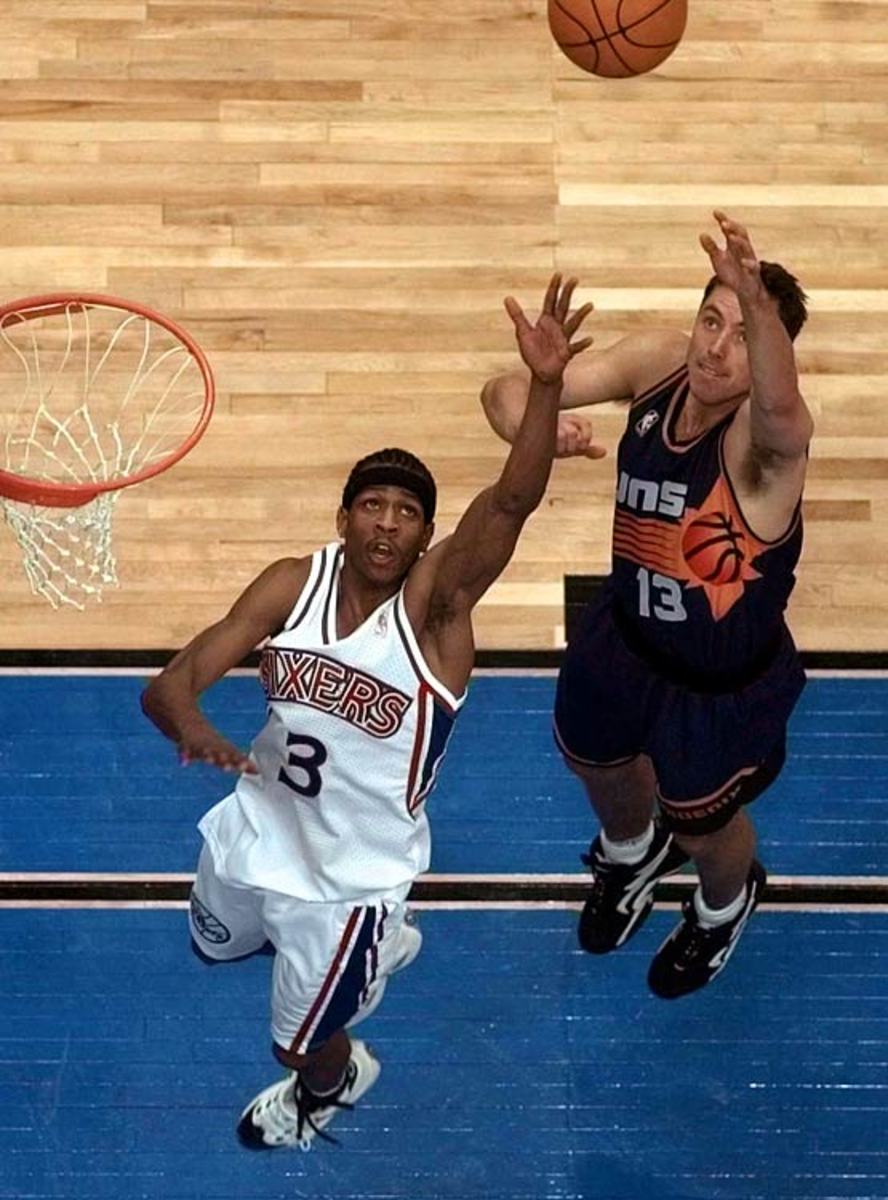
Nash was selected by Phoenix with the 15th pick in the first round. He was considered the best pure point guard in the draft, compared to the natural scorers like Allen Iverson and Stephon Marbury, who were also listed at the position.
Steve Nash and Yudi Abreu
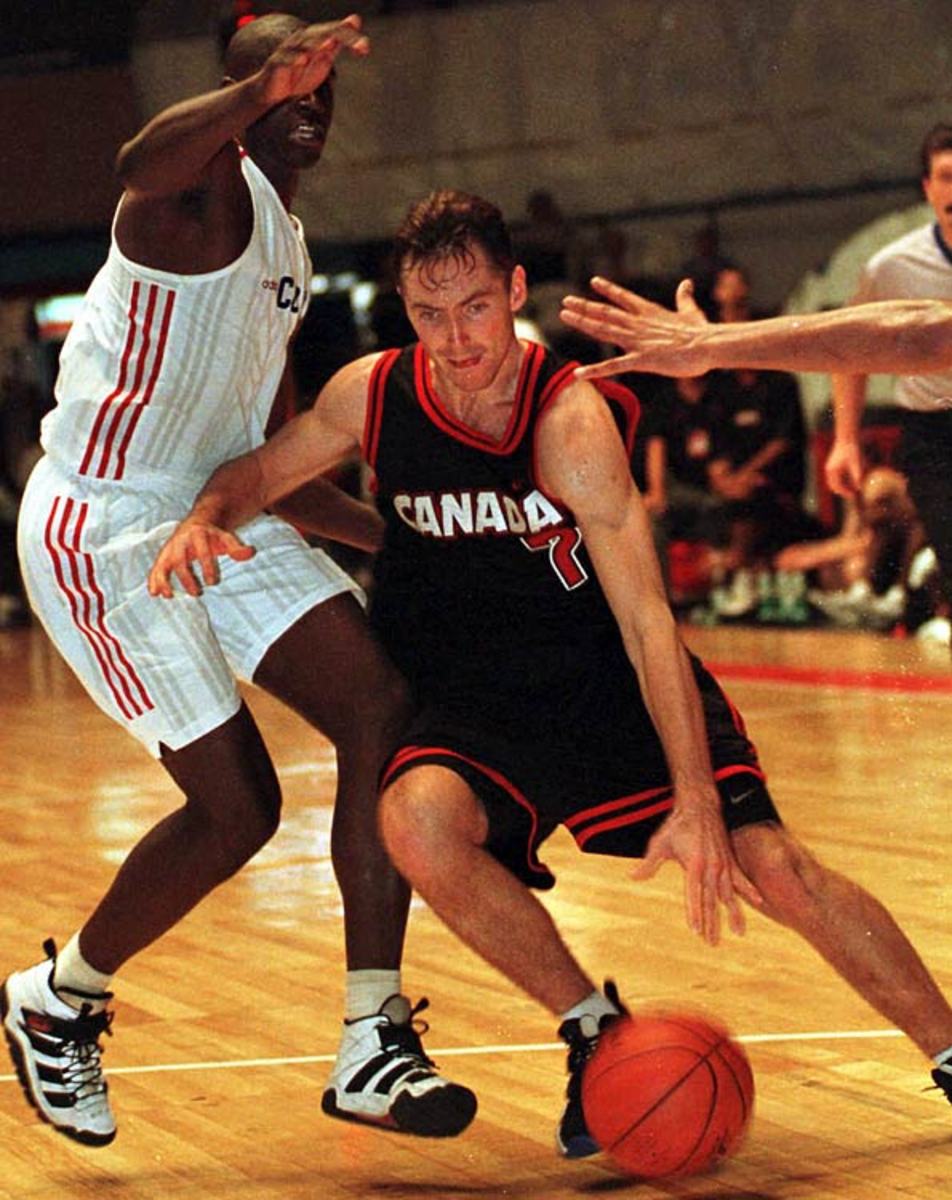
Nash also competed for the Canadian National Team, culminating in the team's appearance at the 2000 Olympics in Sydney. He also captained the team in 2004, but it did not qualify for an Olympic spot. In this photo, Nash drives around Cuba's Yudi Abreu during a Tournament of the Americas game in Montevideo, Uruguay.
Dallas Mavericks
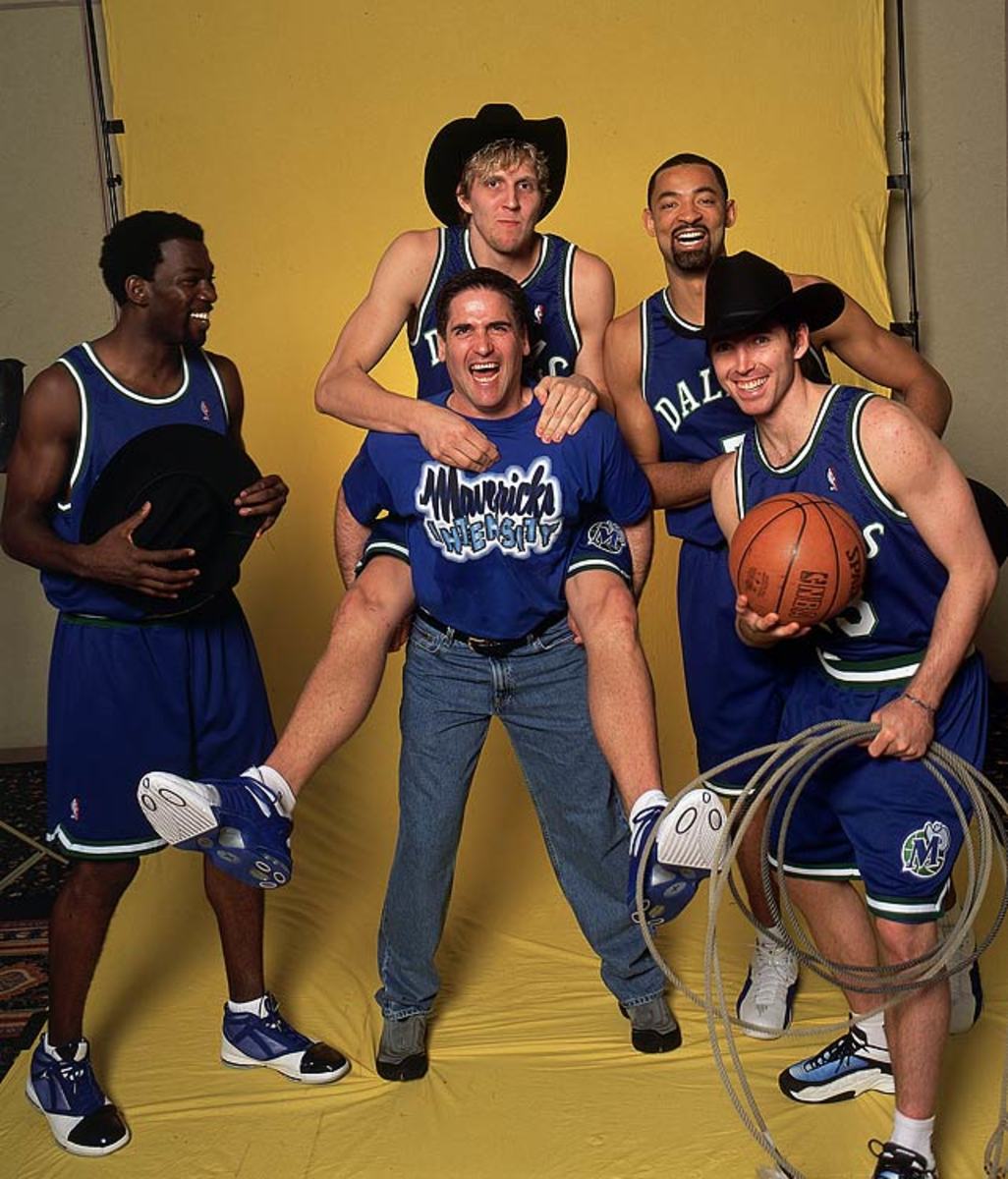
After two mediocre seasons in Phoenix, Nash was traded to Dallas for Martin Muursepp, Bubba Wells, Pat Garrity and a first-round draft pick. The Mavs struggled at first, but the drafting of Dirk Nowitzki and the acquisition of Michael Finley and Juwan Howard turned the Mavericks into contenders. The person with the biggest impact on Dallas' success was Mark Cuban, who purchased the team in 2000 and instantly turned them into contenders.
Dallas Mavericks

Under Cuban (second from left), the Mavs capitalized on the NBA's growth in international players including Eduardo Najera (Mexico), Wang Zhizhi (China), Steve Nash (Canada), Tariq Abdul-Wahad (France) and Dirk Nowitzki (Germany).
Western Conference All-Stars
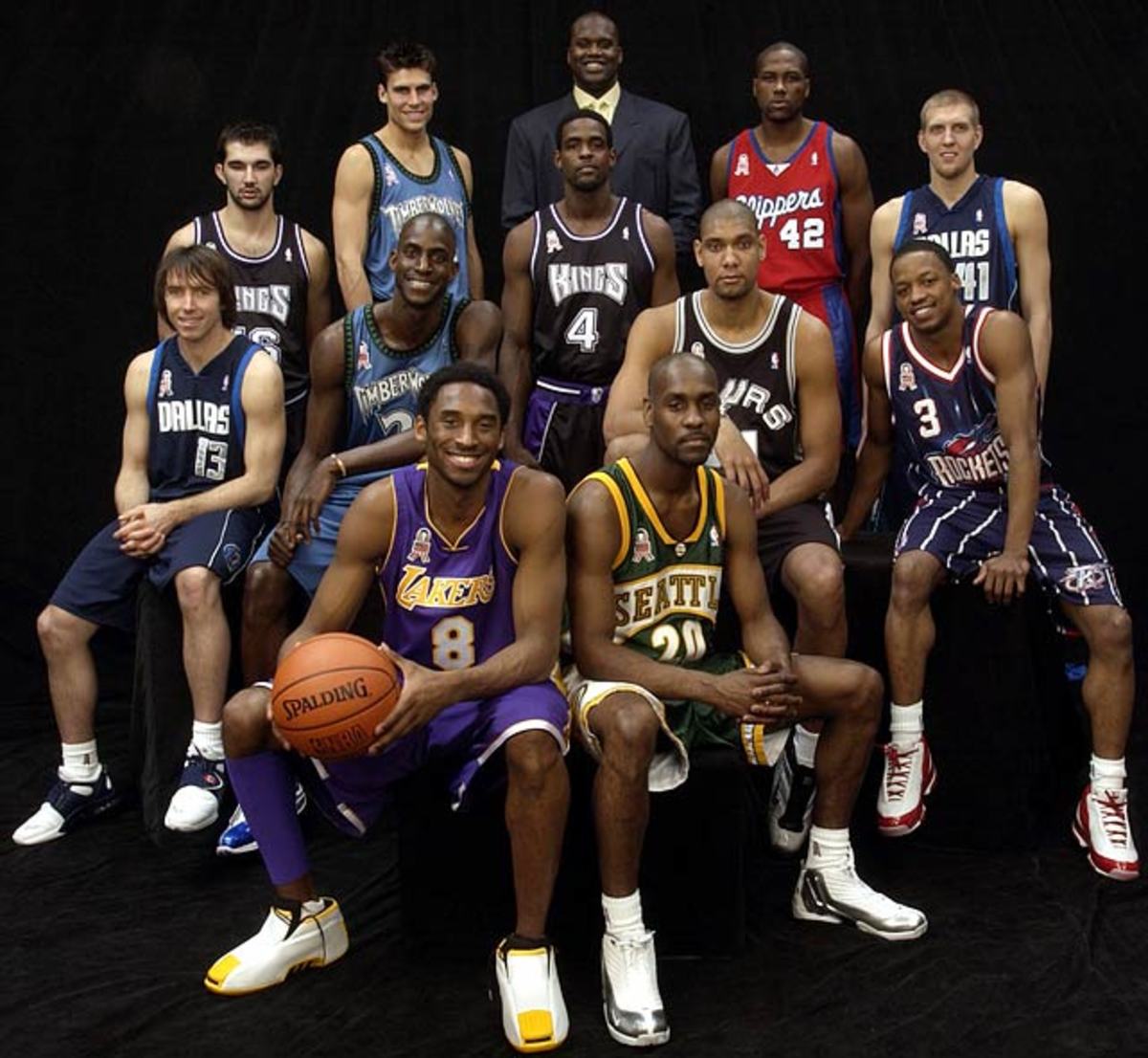
Nash poses with the Western Conference All-Stars during the NBA's 2002 All-Star Weekend in Philadelphia. The point guard dished out nine assists in the team's 135-120 triumph.
Steve Nash and Dirk Nowitzki
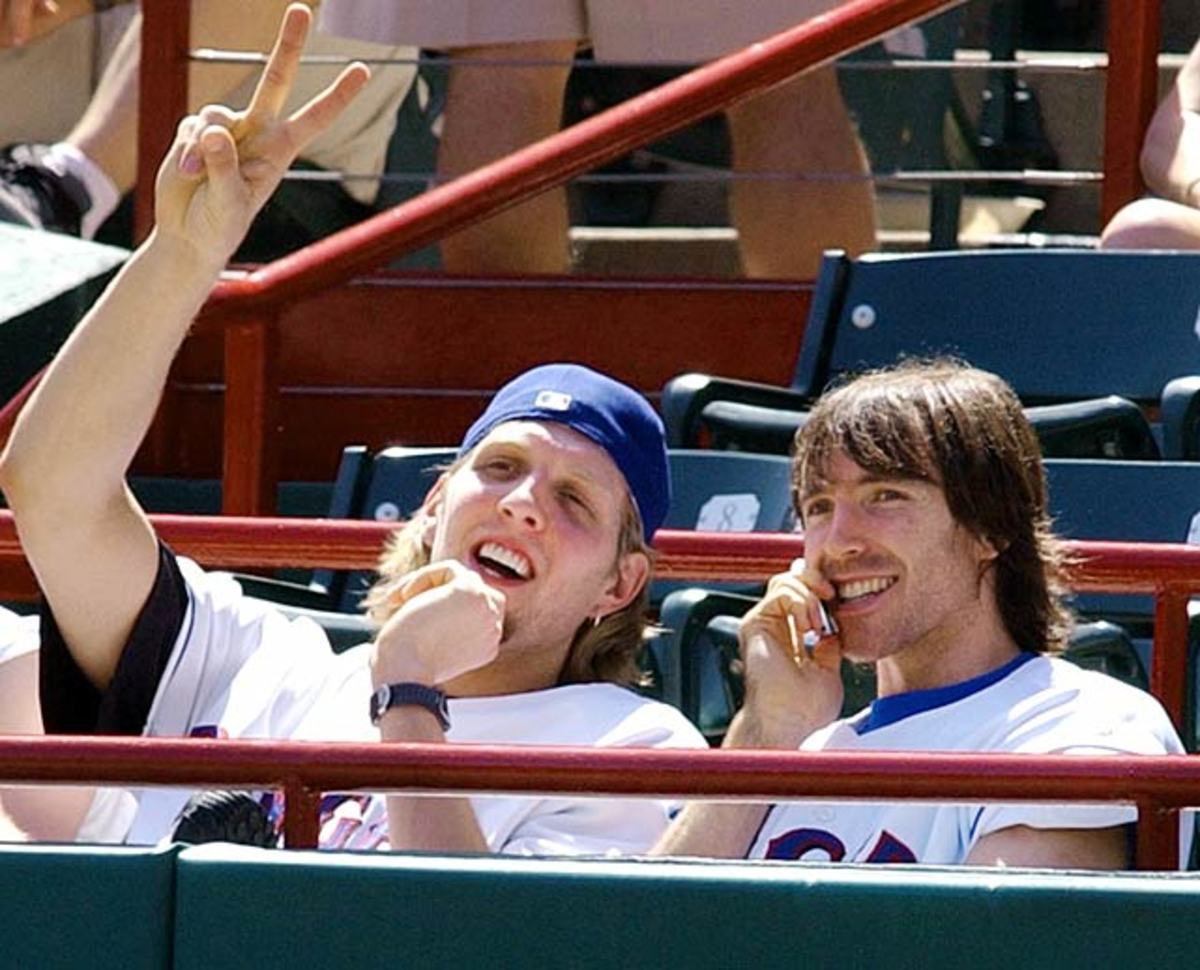
Nash and then-Mavericks teammate Dirk Nowitzki take in an April 2003 Rangers game. The two made quite the tandem that year, with Nash averaging 17.7 points and 7.3 assists per game and Nowitzki racking up 25.1 points per game. Dallas advanced to the Western Conference Finals before falling to the San Antonio Spurs.
Steve Nash

Nash shows off his soccer skills as Sports Illustrated writer Jack McCallum looks on.
Steve Nash and Jerry Colangelo
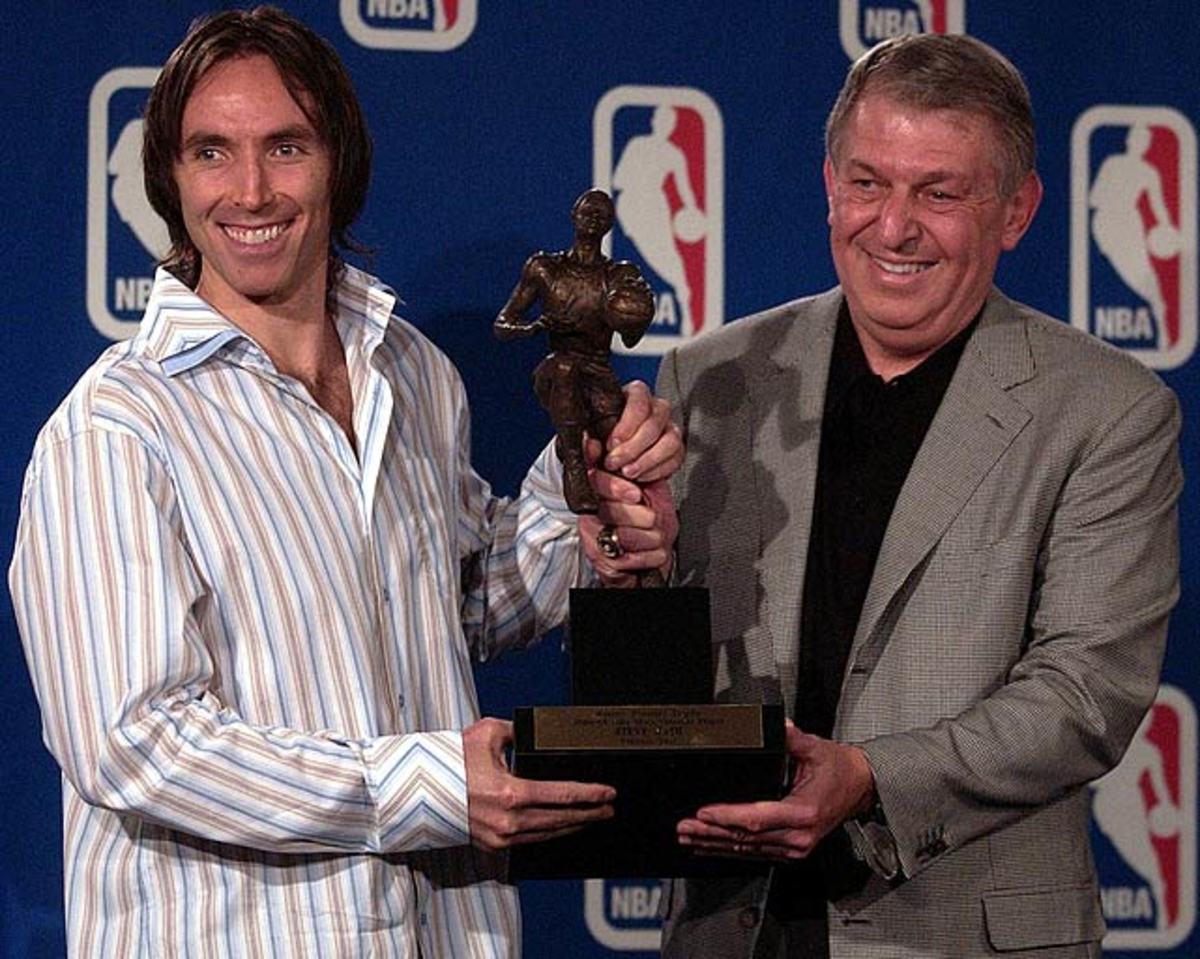
Established as one of the most unselfish players in the league, Nash received some hardware of his own in 2005. Jerry Colangelo presents him with the MVP Trophy, the first of two consecutive seasons he'd bring home the award.
Steve Nash and Fan
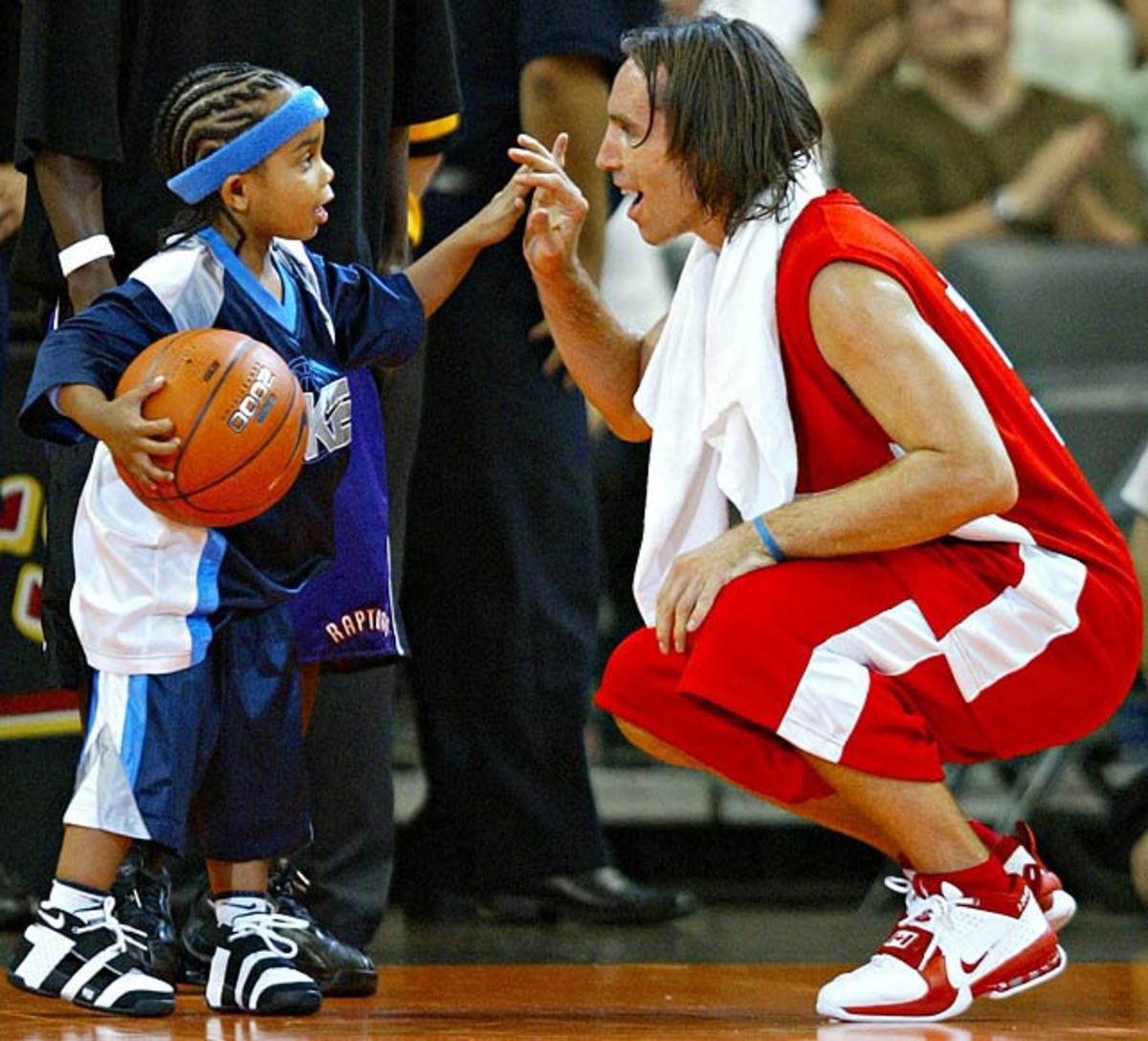
Nash squats to high-five one of his young admirers during a charity basketball event in 2005. He continues to be a fan-favorite, as he's been named to the All-Star Game seven times.
Yao Ming and Steve Nash
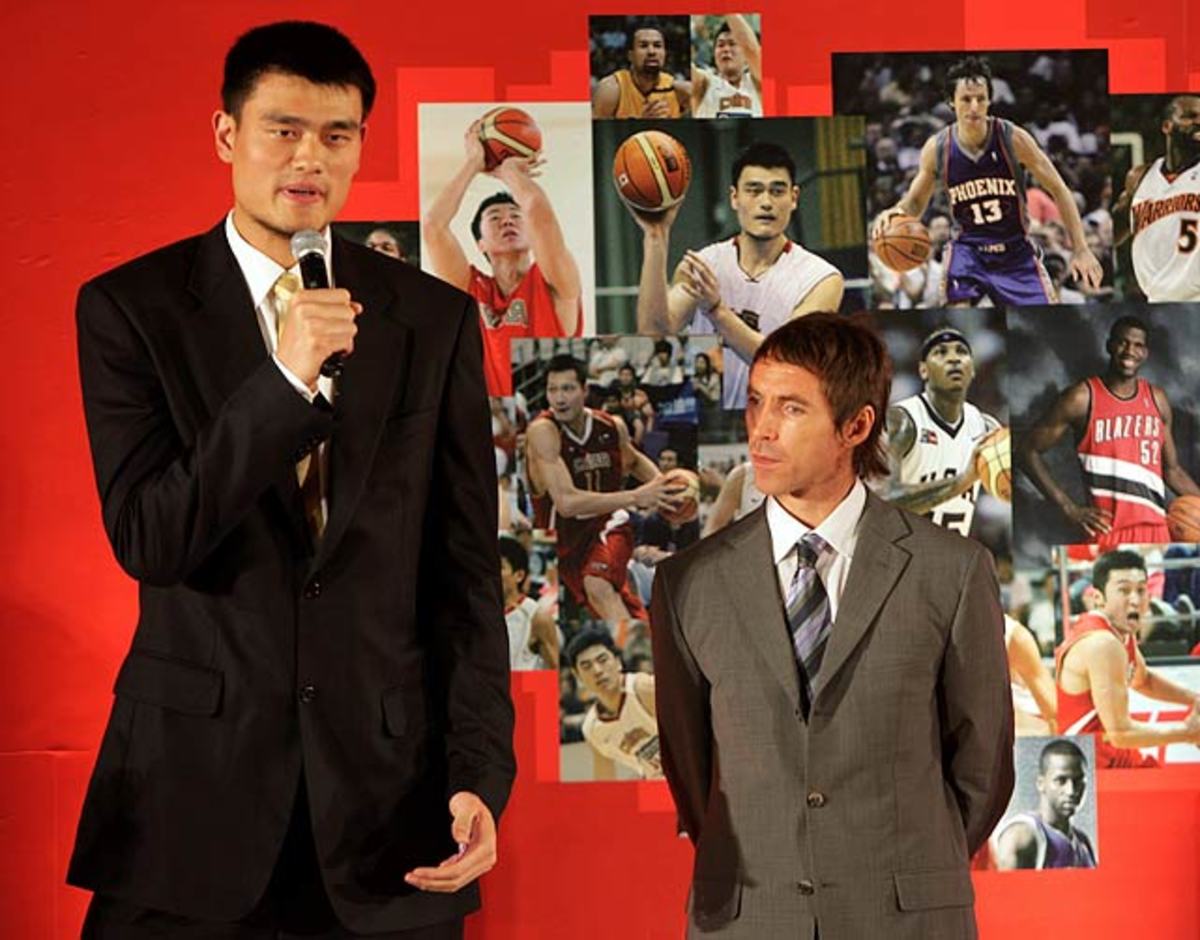
Never the tallest player in the NBA, the 6-foot-3 Nash looked shorter than ever when stationed next to the 7-foot-5 Yao Ming. Luckily, he's usually asked to guard Aaron Brooks and not the Chinese standout when Phoenix takes on Western Conference foe Houston.
Steve Nash

The view from above as Nash brings up the ball against Devin Harris and the Mavericks.
Steve Nash

Taking in another baseball game, Nash watches the Yankees play the Red Sox in 2008. He's an avid fan of baseball, soccer and hockey in addition to the NBA.
Steve Nash and Thierry Henry
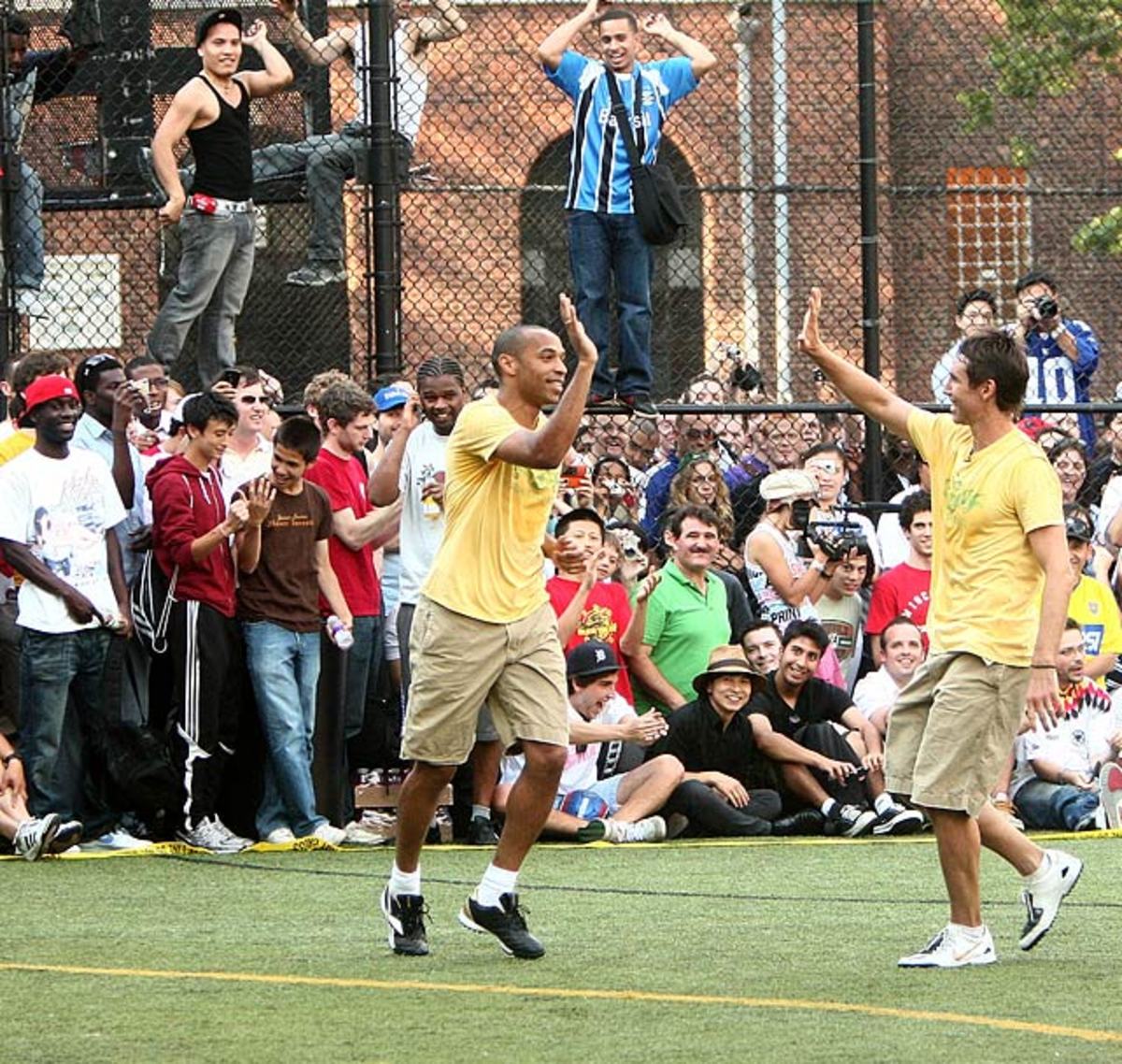
Nash celebrates with Thierry Henry during the Showdown in Chinatown celebrity soccer match in New York City in 2008. A multi-sport talent, Nash also put his soccer skills on display during the 2005 Slam Dunk contest, heading a pass to Amare Stoudemire to spark a spectacular jam.
Steve Nash and Alejandra Amarilla
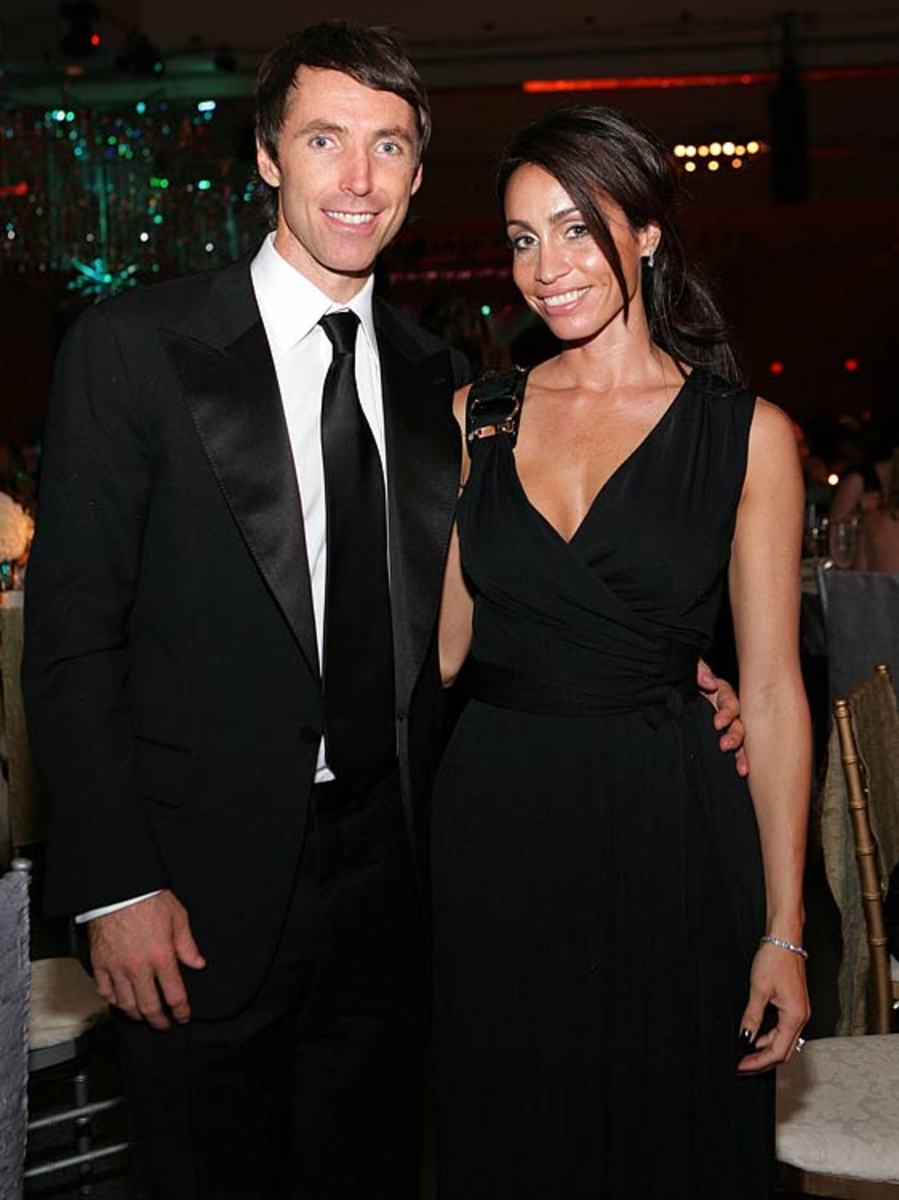
A celebrity off the court as well as on it, a sharply-dressed Nash takes a photo with wife Alejandra Amarilla. The couple has three children together, including their latest, Matteo, who was born on Nov. 12, 2010. They announced their divorce just one day after his birth.
Steve Nash and Jeff Van Gundy
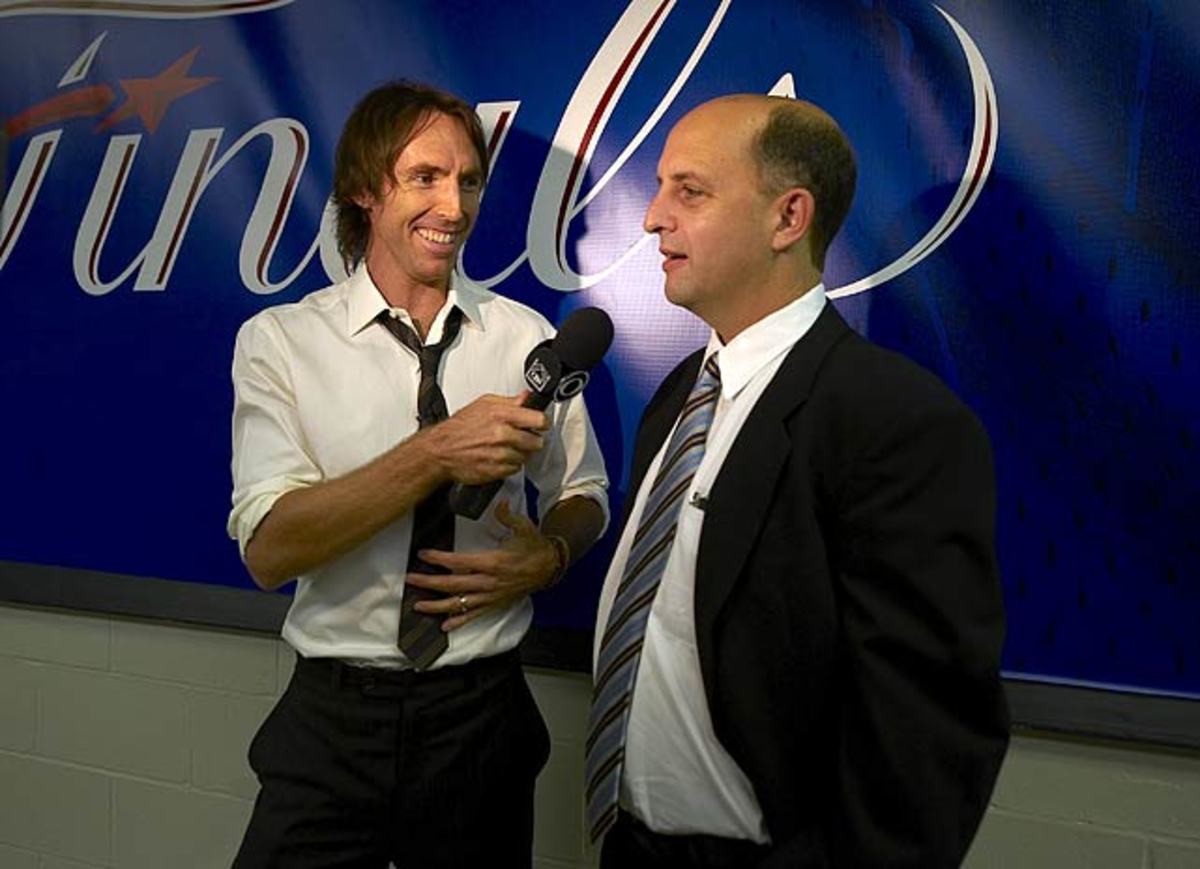
Nash's versatility extends beyond the court, as he served as a reporter for the Late Show with David Letterman before a 2009 Finals game between the Magic and Lakers. Here, his interview subject is Jeff Van Gundy.
Steve Nash

The first NBA player ever to carry the Olympic Torch, Nash hoists the flame during the opening ceremonies for the 2010 Vancouver Games. He helped light the cauldron with fellow countrymen Wayne Gretzky, Nancy Greene and Catriona Lemay Doan.
Steve Nash

Known for his gritty play, Nash broke his nose in the 2010 Western Conference Finals after he was head-butted by a charging Derek Fisher. Toughened by his childhood as hockey player in Canada, he shook off the injury, then proceeded to shake off the Lakers. Phoenix cruised to a 118-109 in Game 3.
Steve, Lola and Bella Nash
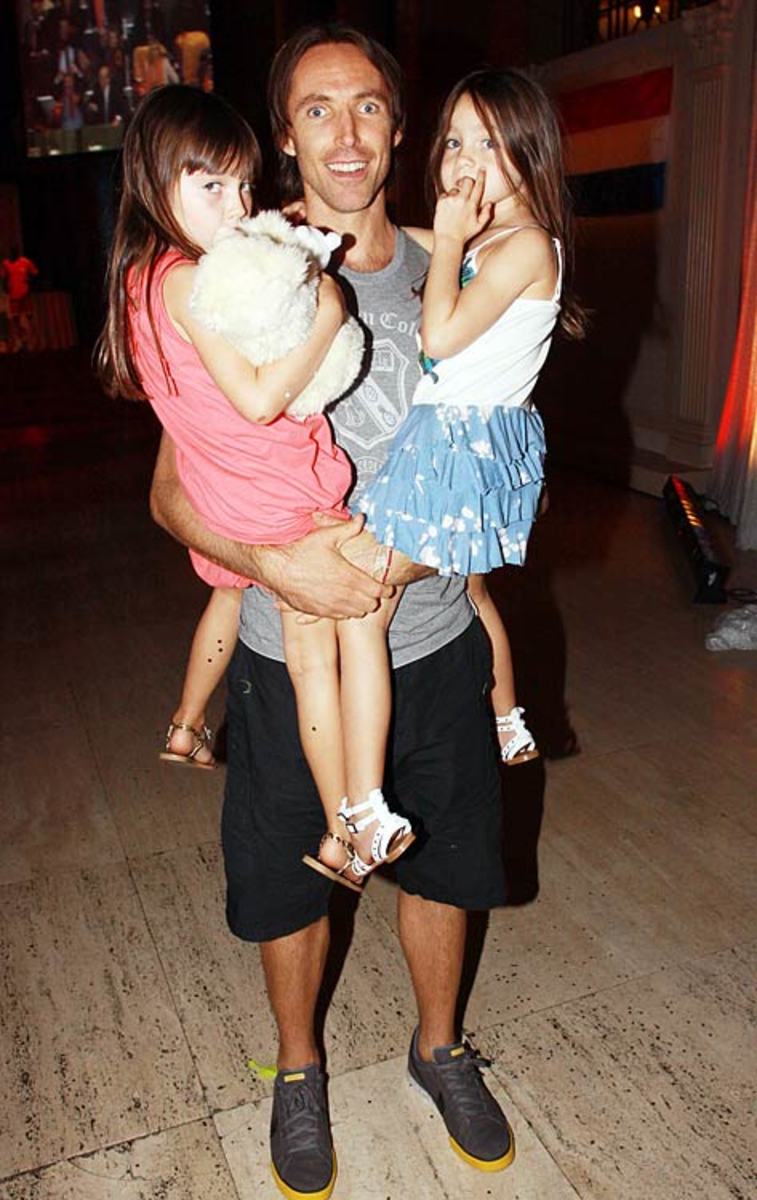
Holding his twin daughters Lola and Bella, Nash takes a picture after the World Cup Final in 2010. The girls were born on Oct. 14, 2004.
Steve Nash and Ezra Holland
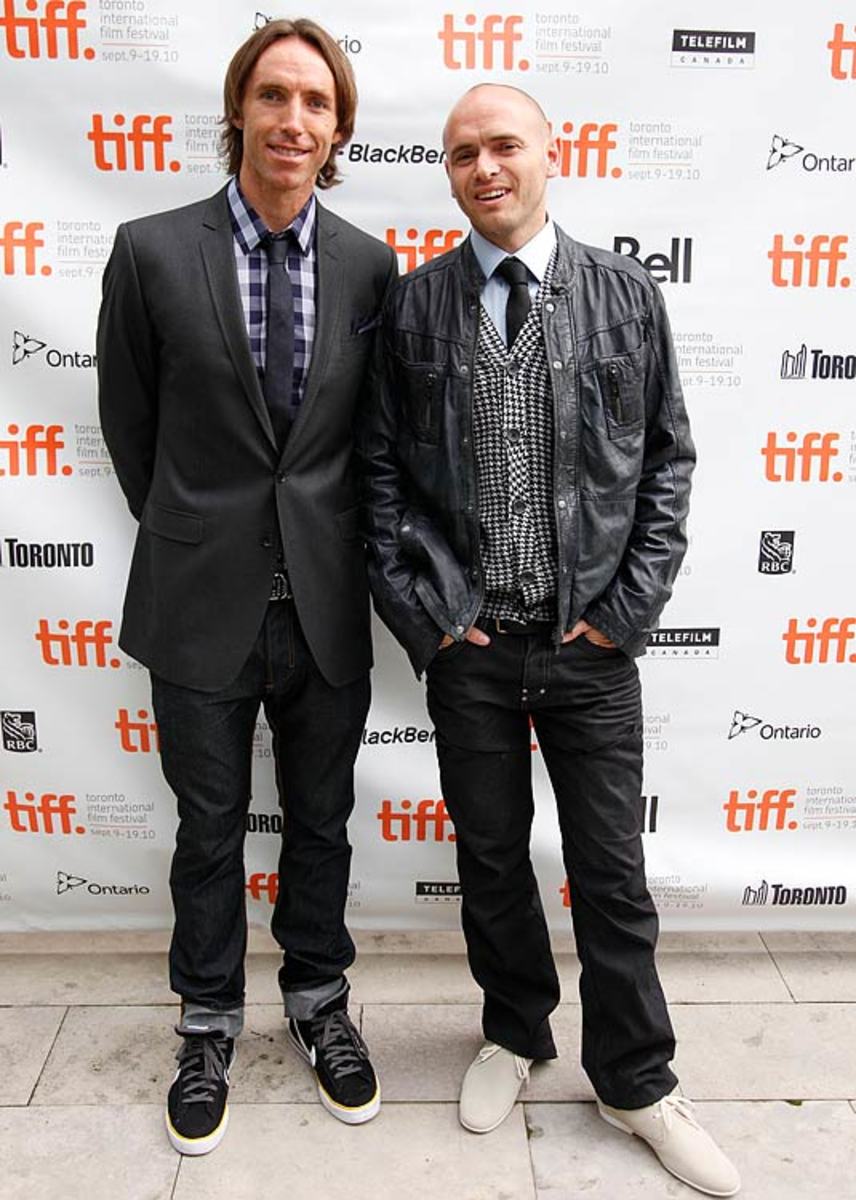
Nash smiles for the camera with Ezra Holland before the premiere of their movie Into the Wind in 2010. The story, Nash's filmmaking debut, details the tale of Terry Fox, a marathon runner trying to raise cancer awareness. It was featured in ESPN's 30 for 30 campaign.
Steve Nash and Amare Stoudemire
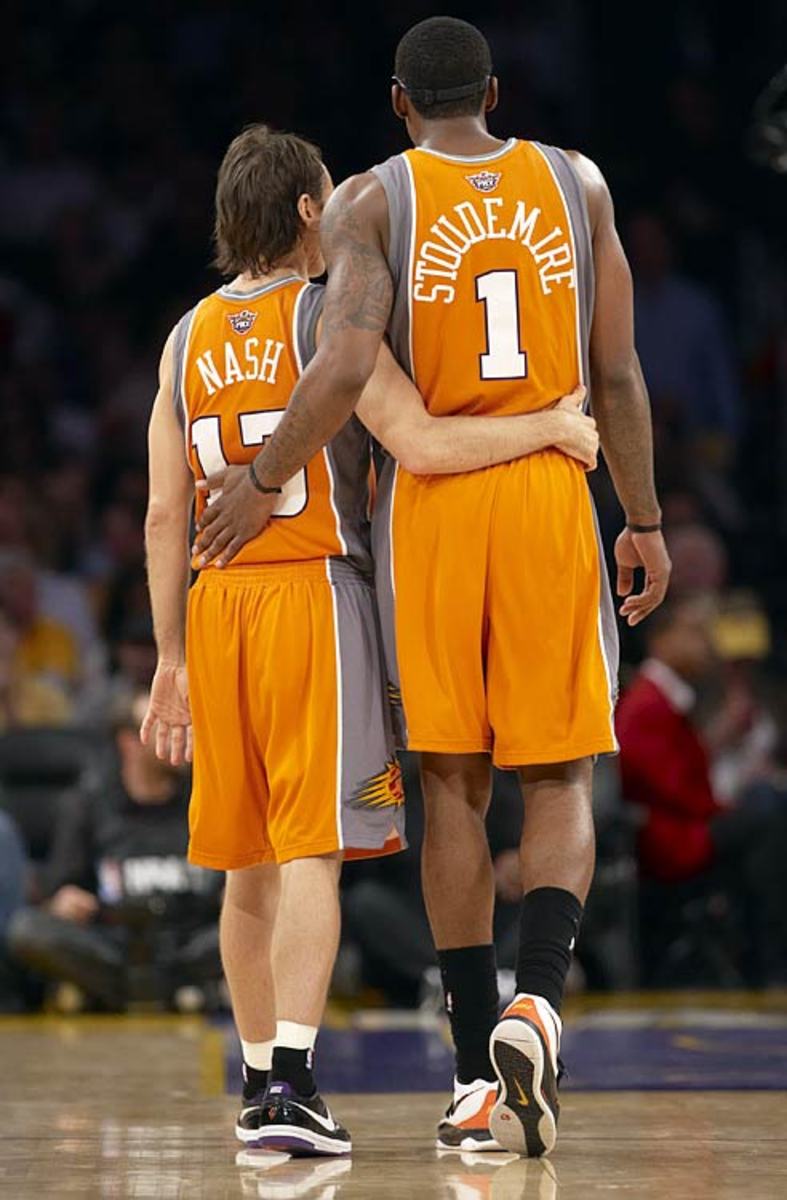
A dynamic duo, Nash and Amare Stoudemire share an embrace during Game 2 of the 2010 Western Conference Finals. The Suns would drop the contest 124-112, but would stun the Lakers for victories in Games 3 and 4 to even the series at two. They suffered hard-fought losses in Games 5 and 6, though, as Los Angeles went on to claim a repeat NBA title.
